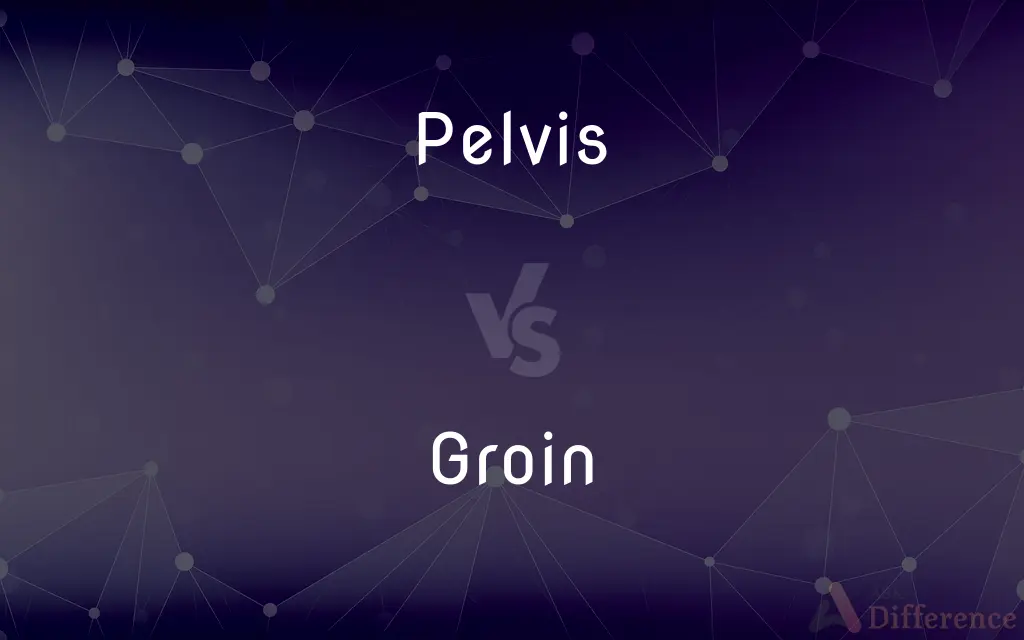Pelvis vs. Groin — What's the Difference?
Edited by Tayyaba Rehman — By Maham Liaqat — Updated on March 18, 2024
The pelvis is a complex bony structure in the lower abdomen, while the groin refers to the area between the abdomen and thigh.

Difference Between Pelvis and Groin
Table of Contents
ADVERTISEMENT
Key Differences
The pelvis, comprising several bones including the hip bones, sacrum, and coccyx, serves as a support structure for the lower body and protects internal organs. Whereas, the groin is the area on either side of the body where the abdomen meets the upper thigh, encompassing muscles, ligaments, and tendons.
While the pelvis is a critical part of the skeletal system providing structural stability and support for locomotion, the groin primarily functions as a passageway for important nerves, blood vessels, and the inguinal canal, crucial for muscle attachment and movement.
Pelvic injuries often involve fractures or dislocations due to significant trauma and can affect internal organs, requiring medical attention. In contrast, groin injuries usually involve strains or sprains of the muscles and tendons, often occurring during physical activities like sports.
The health of the pelvis is crucial for functions such as walking, sitting, and bearing the weight of the upper body, highlighting its role in overall mobility and posture. On the other hand, the groin's health is essential for specific movements, including leg rotation, flexion, and providing stability and flexibility.
Issues affecting the pelvis can include conditions like pelvic inflammatory disease (PID), fractures, and arthritis, which can impact general movement and reproductive health. Groin issues often involve muscle strains, hernias, and lymphadenopathy, affecting mobility and causing localized pain.
ADVERTISEMENT
Comparison Chart
Anatomy
Bony structure including hip bones, sacrum, coccyx
Area where the abdomen meets the thigh; includes muscles
Function
Supports lower body, protects organs
Passageway for nerves, blood vessels; muscle attachment
Injury Type
Fractures, dislocations, affecting organs
Strains, sprains, affecting muscles and tendons
Role
Essential for walking, sitting, weight bearing
Crucial for leg movement, stability, flexibility
Common Issues
Pelvic inflammatory disease, fractures, arthritis
Muscle strains, hernias, lymphadenopathy
Compare with Definitions
Pelvis
Includes arthritis and pelvic inflammatory disease.
Pelvic inflammatory disease can affect fertility if untreated.
Groin
Prone to strains and hernias due to overexertion.
Groin strains often require rest and physical therapy for recovery.
Pelvis
Provides structural stability and supports organs in the lower abdomen.
The pelvis houses reproductive organs and part of the digestive system.
Groin
Facilitates leg movement and supports abdominal muscles.
The groin's muscles are crucial for sprinting and jumping.
Pelvis
Susceptible to fractures and dislocations from impacts.
Pelvic fractures can result from falls or direct blows.
Groin
Muscle strains, hernias, and lymph node inflammation.
Groin hernias may need surgical repair if they become obstructed or painful.
Pelvis
The lower part of the torso, enclosed by the hip bones, sacrum, and coccyx.
The pelvis supports the weight of the upper body and connects to the spine.
Groin
The area between the abdomen and thigh, where several muscles and tendons converge.
Groin injuries are common in athletes.
Pelvis
Central to posture, mobility, and reproductive functions.
A healthy pelvis is vital for pain-free movement and childbirth.
Groin
Plays a role in leg stability and flexibility.
Strengthening the groin muscles can improve athletic performance.
Pelvis
The pelvis (plural pelves or pelvises) is either the lower part of the trunk of the human body between the abdomen and the thighs (sometimes also called pelvic region of the trunk) or the skeleton embedded in it (sometimes also called bony pelvis, or pelvic skeleton). The pelvic region of the trunk includes the bony pelvis, the pelvic cavity (the space enclosed by the bony pelvis), the pelvic floor, below the pelvic cavity, and the perineum, below the pelvic floor.
Groin
The area between the abdomen and the upper thigh on either side of the body.
Pelvis
The large bony frame near the base of the spine to which the hindlimbs or legs are attached in humans and many other vertebrates.
Groin
A curved edge formed by two intersecting vaults.
Pelvis
The broadened top part of the ureter into which the kidney tubules drain.
Groin
US spelling of groyne
Pelvis
The cavity formed by this structure.
Groin
(Anatomy) The crease or hollow at the junction of the inner part of each thigh with the trunk, together with the adjacent region and often including the external genitals.
Pelvis
See renal pelvis.
Groin
(Architecture) The curved edge at the junction of two intersecting vaults.
Pelvis
(anatomy) A funnel-shaped cavity, especially such a cavity in the kidney into which urine passes towards the ureter
Groin
A small jetty extending from a shore to protect a beach against erosion or to trap shifting sands.
Pelvis
The pelvic arch, or the pelvic arch together with the sacrum. See Pelvic arch, under Pelvic, and Sacrum.
Groin
To provide or build with groins.
Pelvis
The calyx of a crinoid.
Groin
The crease or depression of the human body at the junction of the trunk and the thigh, together with the surrounding region.
Pelvis
The structure of the vertebrate skeleton supporting the lower limbs in humans and the hind limbs or corresponding parts in other vertebrates
Groin
The area adjoining this fold or depression.
He pulled a muscle in his groin.
Pelvis
A structure shaped like a funnel in the outlet of the kidney into which urine is discharged before passing into the ureter
Groin
(architecture) The projecting solid angle formed by the meeting of two vaults
Groin
(euphemistic) The genitals.
He got kicked in the groin and was writhing in pain.
Groin
(geometry) The surface formed by two such vaults.
Groin
To deliver a blow to the genitals of.
In the scrum he somehow got groined.
She groined him and ran to the car.
Groin
(architecture) To build with groins.
Groin
To hollow out; to excavate.
Groin
To grunt; to growl; to snarl; to murmur.
Groin
The snout of a swine.
Groin
The line between the lower part of the abdomen and the thigh, or the region of this line; the inguen.
Groin
The projecting solid angle formed by the meeting of two vaults, growing more obtuse as it approaches the summit.
Groin
The surface formed by two such vaults.
Groin
A frame of woodwork across a beach to accumulate and retain shingle.
Groin
To grunt to growl; to snarl; to murmur.
Bears that groined coatinually.
Groin
To fashion into groins; to build with groins.
The hand that rounded Peter's dome,And groined the aisles of Christian Rome,Wrought in a sad sincerity.
Groin
The crease at the junction of the inner part of the thigh with the trunk together with the adjacent region and often including the external genitals
Groin
A protective structure of stone or concrete; extends from shore into the water to prevent a beach from washing away
Groin
Build with groins;
The ceiling was groined
Common Curiosities
Are pelvic conditions more serious than groin issues?
Pelvic conditions can be more complex and affect more critical functions.
What is the main function of the pelvis?
To support the lower body and protect internal organs.
Can groin injuries lead to complications?
Yes, such as chronic pain or hernias requiring surgical intervention.
How is the groin related to movement?
It's critical for leg movement, providing stability and flexibility.
Can both pelvis and groin injuries affect mobility?
Yes, both can significantly impact mobility but in different ways.
Are there specific exercises for pelvic health?
Yes, exercises like pelvic tilts and kegel exercises can improve pelvic health.
Are pelvic fractures common in certain sports?
They're more common in contact sports or sports with a high risk of falls.
Is it possible to have both pelvis and groin injuries simultaneously?
Yes, especially due to physical trauma or accidents.
What distinguishes pelvis pain from groin pain?
Pelvis pain often relates to the skeletal structure, whereas groin pain usually involves soft tissues.
What role does the pelvis play in childbirth?
It provides a passageway for the baby during vaginal delivery.
How can one prevent groin strains?
Through proper warm-up, stretching, and strengthening exercises.
Can groin pain be a sign of a hernia?
Yes, hernias often cause pain and bulging in the groin area.
What is pelvic inflammatory disease?
An infection of the female reproductive organs, often from STIs.
Can groin issues affect sexual health?
Indirectly, by causing pain or discomfort that impacts sexual activity.
How are groin strains treated?
With rest, ice, compression, elevation, and physical therapy.
Share Your Discovery

Previous Comparison
Virtu vs. Virtue
Next Comparison
Articulation vs. ModulationAuthor Spotlight
Written by
Maham LiaqatEdited by
Tayyaba RehmanTayyaba Rehman is a distinguished writer, currently serving as a primary contributor to askdifference.com. As a researcher in semantics and etymology, Tayyaba's passion for the complexity of languages and their distinctions has found a perfect home on the platform. Tayyaba delves into the intricacies of language, distinguishing between commonly confused words and phrases, thereby providing clarity for readers worldwide.














































